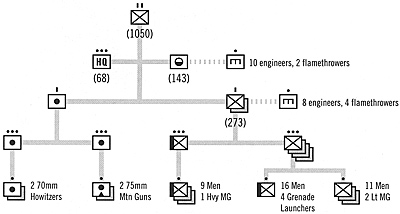 The Japanese Special Naval Landing Forces
were roughly equivalent to the U.S. Marines;
even their wartime path of evolution resembled
that of the U.S. Marines, with one significant
exception -- it was in reverse. As the balance
tipped in their favor, the Marines discarded static
garrison forces like the Defense Battalion in
favor of units designed for the amphibious attack.
The S.N.L.F. began the war by spearheading
Japanese landings; but from 1943 on, they were
tied down in the futile defense of dozens of island
fortresses, usually to the death.
The Japanese Special Naval Landing Forces
were roughly equivalent to the U.S. Marines;
even their wartime path of evolution resembled
that of the U.S. Marines, with one significant
exception -- it was in reverse. As the balance
tipped in their favor, the Marines discarded static
garrison forces like the Defense Battalion in
favor of units designed for the amphibious attack.
The S.N.L.F. began the war by spearheading
Japanese landings; but from 1943 on, they were
tied down in the futile defense of dozens of island
fortresses, usually to the death.
As of the attack on Pearl Harbor, thirty-one Special Naval Landing Forces were in existence. Most of these were later dissolved, destroyed or converted into defensive garrisons as the war turned against Japan. (The 2d Maizuru -- which took Wake -- is a case in point. A month after the conquest it was redesignated the 8th Base Force and sent to join the garrison at Rabaul naval base.)
The organization shown above is more ideal then practical. In reality, Landing Forces were usually put together according to their task and from the available units. This kind of widespread shuffling meant that there was a host of different, and usually ad hoc, arrangements of S.N.L.F. troops, all of which bore the title "landing force."
The Landing Force had a number of distinct weaknesses when compared to later Marine units doing the same job. For one thing, there wastA enough artillery, and what there was lacked the necessary punch. (Similar Marine units could depend on the fire support of guns ranging from 75 millimeters howitzers on up to 155 millimeter field guns. The Landing Force seldom had anything better than the 75 millimeter mountain gun.) On the other hand, it did have a respectable number of flame-throwers- a weapon that would be used against the Japanese with terrifying efficiency later- but the equipment seems to have been clumsy, and, at least at Wake, ineffective.
The Special Naval Landing Forces displayed the characteristic trait of all Japanese efforts in World War II; long on courage and very short on material. Most of the Landing Forces would ultimately be destroyed as the 1st Defense Battalion was -- fighting alone and unsupported against a foe who controlled both the seas and the skies.
America's Forlorn Hope US Marines Defend Wake Island: Dec 8-23, 1941
- Introduction
First Attack: Air Raid
IJN Invasion Repulsed
IJN Invasion: Round Two
Surrender and Bibliography
Map: Wake Island
VMF-211
US Marines Defense Battalion
Imperial Japanese Special Naval Landing Force
Back to Table of Contents -- Against the Odds vol. 1 no. 2
Back to Against the Odds List of Issues
Back to MagWeb Magazine List
© Copyright 2003 by LPS.
This article appears in MagWeb.com (Magazine Web) on the Internet World Wide Web.
Other articles from military history and related magazines are available at http://www.magweb.com
* Buy this back issue or subscribe to Against the Odds direct from LPS.
